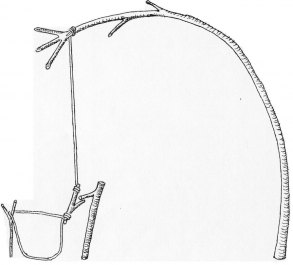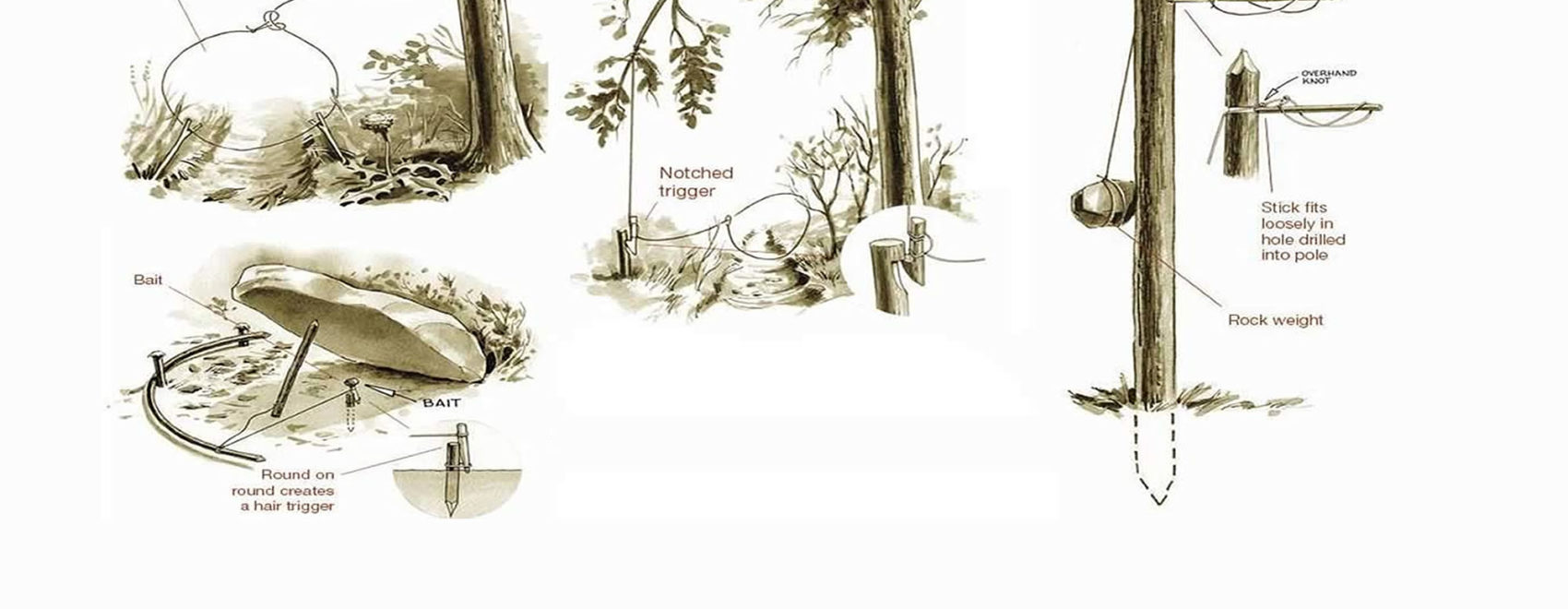Trapping Small Game in a Survival Situation
There are many survival scenarios; some take only a few days, others might run into weeks, months or even years. The longer the time, the more critical food supply becomes. Even for the best-stocked bug-out location, a long period under survival conditions will strain the food reserves, and the need for fresh food will increase. That’s why most long-term survival plans include food gathering (mainly plants), hunting, and trapping.
Why trap for survival
Even assuming that you have ample stocks of dehydrated food it’s beneficial to supplement with fresh foods – plants with fresh vitamins, meats with fresh protein and fats. Gathering edible plants is obvious, although often time consuming and not necessarily easy for larger quantities. Likewise hunting for larger animals, generally deer, is obvious.

The payoff from taking a larger animal is great, although success is not guaranteed, nor is the ability to preserve the meat. Trapping – the use of various kinds of traps – to take smaller mammals (rabbits, squirrels), birds and fish for food – does not guarantee success but it is a numbers game. Put out more traps in the right places and the likelihood of success goes up.
Most of the game taken by trapping is for immediate consumption (within a few days), but the idea is to achieve a regular supply.
There is a valid argument that hunting with a rifle or bow can do anything that can be done by trapping, and it’s a lot more familiar to most people. On the other hand, when hunting, the need for concentration means you aren’t going to be doing anything else. For sport hunting, that’s great. It’s exactly the experience you want. In a survival situation, the hours spent hunting aren’t available to do a thousand other things that need doing. With trapping, once the traps are set, you’re free to do other things, even sleep, until you need to check the traps again.
One other thing, which may or may not be important depending on the situation – hunting with a firearm is noisy and uses ammunition. Trapping is silent.
Observation skills of Tapping
If there’s one thing necessary for success in trapping for survival, it’s observation skills. To put it succinctly, you won’t trap what you don’t know about. That means observing the environment – methodically – to learn what species are available (fish, birds or mammals), how abundant they are, and where they are located. For the most part, these are the same skills as a naturalist, only with a different purpose – acquiring food.
As expert trappers will tell you, the cornerstones of successful trapping are knowing where and how you place the traps. To know where to place traps, you need to observe where the animals feed and move about – their trails, food sources, watering holes, defecation sites, nests and gathering places. There’s a lot more to it than that, as you’ll see in Survivalist 101 Tutorial: Survival Trapping – What and Where to Trap, but it all starts with gaining knowledge about the potential animals for trapping.
The experience factor of Trapping

The knowledge of animals and their behavior doesn’t arrive through osmosis. Likewise, the knowledge of traps, how to use them, and the skills needed for successful trapping mostly come from experience. Yes, it helps to read about it.
A lot of information about animals and to a certain extent about trapping can be found online and in printed material; but there is no substitute for building a trap device, studying the available animals, picking a location for a trap, setting the trap and seeing what happens.
When nothing happens, you try to identify mistakes and learn from them. As the saying goes, “An expert is somebody who has made all the usual mistakes.”
Despite the inherent violence of trapping, it’s a subtle process – some people would call it an art. This is another way of saying that in some ways trapping may be more difficult, at least for some people, than pointing a gun and shooting something. On the other hand, for many people, it’s the challenge of trapping that makes it interesting – above and beyond putting fresh food on the table.
The legality and ethics of trapping
The thing to keep in mind is the articles in this tutorial are about survival in potential life and death situations. It’s about one way to provide food when there is an emergency. Most of the time, however, there is no emergency and trapping is mainly a commercial activity concerned with gathering skins and pelts or with reducing the population of unwanted animals.
That’s why trapping is an activity that has long been tightly regulated and hedged with laws. These laws vary from state to state in the same way laws vary for hunting. For example, in many states it’s illegal to use nets for freshwater fishing except (if at all) in specific locations, during specific times, for specific species of fish, for example catching smelt with dip nets in the Great Lakes (Minnesota, Wisconsin, Ohio, New York and Michigan).
In practical terms, this means unless there is an actual survival emergency, gaining experience in trapping should follow laws and regulations. This may exclude techniques that will be necessary in a survival situation. It’s also possible that licenses or certification will be required to trap certain species. In any case, telling a game warden, “I’m learning my survival skills” won’t save you from a fine. It’s up to you to know the regs in the area where you intend to practice survival trapping.
There’s also the matter of trapping ethics. This is a big, touchy subject. It involves potential cruelty to animals. It involves potential over-trapping or poaching. It may involve rare or endangered species (traps are not very discriminating).
In fact, it might also involve potential harm to people, as some traps can be physically damaging or even lethal. While some of these considerations change in an emergency, they don’t all go away. If you think about it, these are pretty much the same issues for hunting. How you feel about them should be about the same.
Hopefully, these will provide a useful overview of survival trapping, but they can hardly cover everything – and they are definitely not a substitute for gaining experience by doing. Perhaps you might be one of those people who discover that trapping – especially learning to read the environment from a food trapper’s perspective and building your own traps – makes a great hobby. At the least, you will understand that survival trapping is a good way to provide food if you know enough about how to do it.

